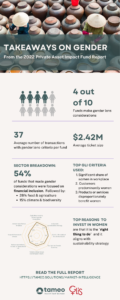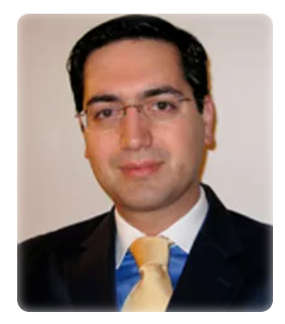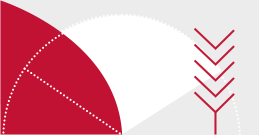
Gender Considerations in Private Asset Impact Funds in Emerging & Frontier Markets
You may have missed it, but just before the holidays, Tameo Impact Fund Solutions launched its 2022 edition of the Private Asset Impact Fund (PAIF) Report. For those of you who are not familiar with this piece of research, it is the compilation of a survey of nearly 200 private market impact funds in emerging and frontier markets, representing approximately a third (37%) of the total $84B market.
In 2022, the Gender Lens Initaitive for Switzerland (GLIS) worked with Tameo to permanently add a gender lens section to their methodology to begin building a base of research on how private asset impact funds are thinking about and incorporating gender considerations into their investment process.
Here are a few of the key findings that we found the most interesting from this year’s survey.
Context: The average fund size of the overall PAIF sample was $153M USD. Funds invest in a variety of geographies but two regions represent more than 50% of portfolio allocation – Latin America & Caribbean (25%) and Eastern Europe & Central Asia (27%).
- Investment managers answered questions about gender balance in their organizations. Investment managers ranged from 44-51% women in their workforce overall but that number was smaller in more important decision-making roles. C-suite ranged from 29%-44%, Board Directors ranged from 24%-39, and Investment Committee members ranged from 17% to 29%.
- 78 of the 198 funds (39%) that completed the PAIF survey made gender lens considerations. On average, these funds have 69% of their portfolio invested with a GLI approach. In 59% of these funds, gender was one of the most important decision factors, alongside other top impact priorities.
- The most-cited reason for adopting GLI strategies was because it is the “right thing to do”, second was that it was “in line with the sustainability strategy”. The least-cited reason was to “attract more female investors” and due to “requests from asset owners.”
- There were a high average number of transactions with gender lens criteria per fund (37 transactions). It is believed that this is because when gender lens strategies are applied, they are applied across the fund and not just on singular transactions. On average, these funds have 69% of their portfolio invested with a GLI approach
- The average ticket size for deals with gender considerations was $2.42M USD compared to $1M USD in the overall sample.
- The geographic portfolio allocation looked different for funds with a gender lens than the overall PAIF sample. The top geographies in the gender lens sample were Latin America & the Caribbean (29%), South Asia (23%), and East Asia & the Pacific (21%). The biggest difference comparatively was in Eastern Europe & Central Asia, in the overall allocation the region represented 27% of the allocation but in gender lens funds it was only 15% of the allocation.
- Exposure to the food & agriculture (28% vs 8%) and climate & biodiversity (15% vs 4%) sectors is much larger in funds that make gender considerations, while there is no exposure to the SME development sector in the overall GLI portfolio.
We recommend checking out the full PAIF report as there are many helpful insights about the market and investment approach in emerging and frontier markets. If you are most interested in the gender sections they can be found on pages 127-130 and 137-145.





